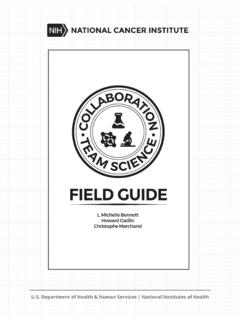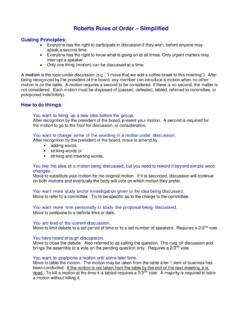Transcription of Communication - NHS England
1 Communication Cross cutting theme for patient safety Sign up to safety creating the conditions for; a safety culture, a just culture, a learning culture and locally led, self directed safety improvement; and building a safer care movement to reduce avoidable harm by half and save 6000 lives. Improvement science Implementation Science Movement methods Campaign methods Evidence based guidance, standards, targets and incentives Bringing to life the five values and behaviours [our pledges] Helping all in the NHS (in England ) address five cross cutting system and human factors Aligning and encouraging the use of five different theories and methods Communication failures Availability and design of the right equipment Individual factors.
2 Well-being, experience, stress, attitudes and relationships Observation failures Information failures be supportive collaborate be honest put safety first continually learn Not assuming we know what works - exploring and questioning current thinking to do things differently Competing priorities Human factors Mental workload Fatigue Boredom Scheduling Barriers Rules Distractions The physical environment Physical demands Device/product design Teamwork Process design Abbreviations Assessment RE(think) solutions Reducing harm topic by topic Relentless focus on the cross cutting factors Use design to remove potential for error Procure the same things across the NHS and standardise where we can The Yorkshire contributory factors framework Rebecca Lawton et al.
3 BMJ Qual Saf 2012;21:369-380 Copyright BMJ Publishing Group Ltd and the Health Foundation. All rights reserved. Focus on cross cutting factors 30 21 18 17 15 13 11 10 10 7 3 Number of organisations CommunicationSafety cultureMortality reviewsPatient engagementLeadershipIncreasing QI and safety skillsNutrition and hydrationIncident analysisTests and screeningSafe staffingTeam workTop 6 Communication The evidence Ineffective Communication among health care professionals is one of the leading causes of error and patient harm Over 70 % of RCAs mention Communication as a contributing factor Nurses cited Communication issues with doctors or ineffective or insufficient Communication among team members Communication failures lead to increases in harm, length of stay, and resource use.
4 As well as reducing staff morale Four categories (1) Delay in communications so that they were too late to be effective (2) Failure to communicate with all the relevant individuals on the team (3) Content that was not consistently complete and accurate (4) Failure to achieve the purpose of the communications issues were left unresolved until the point of urgency The team Health care is complex and unpredictable, with professionals from a variety of disciplines involved in providing care at various times throughout the day, often dispersed over several locations Different professions often have their own view of what the patient needs, with each person prioritising the activities in which he or she acts independently Health care has historically had a hierarchical organisational structure, with significant power distances between doctors and other health care professionals.
5 This frequently leads to a culture of inhibition and restraint in Communication , rather than a sense of open, safe Communication ( psychological safety ) Education and Training Differences in education and training among professions often result in different Communication styles and methods that further complicate the scenario and render communications ineffective Although teamwork and effective Communication are crucial for safe patient care, the educational curricula for most health care professions focus primarily on individual technical skills, neglecting teamwork and Communication skills Human factors and Communication Cognitive overload The effects of stress, fatigue, distractions and interruptions Poor interpersonal communications Imperfect information processing Flawed decision making All contribute to errors in health care Failure to recognise and understand these issues can lead to a culture of unrealistic expectations and blame Intervention attributes Interventions should focus on integrating the critical attributes Collaboration Open Communication Shared responsibilities for planning and problem solving Shared decision making Coordination Key tip Simplify messages.
6 Making the message clear often results in a significant increase in response rates to communications In particular, it s useful to identify how a complex information can be broken down into simpler, easier statements 5 practical tools 1 A standardised Communication tool, such as SBARR 2 An escalation process tool to facilitate timely Communication 3 Daily multidisciplinary rounds using a daily goals sheet 4 Te a m huddles during each shift 5 Briefing and de-briefing at the beginning of shifts, clinics or sessions SBARR Situation What is going on with the patient? Background What is the clinical background or context? Assessment What do I think the problem is? Recommendation What do I think needs to be done for the patient?
7 Read back or response What did you hear from me and what will you be doing now? team huddles A team huddle is defined as a quick meeting of a functional group to set the day/shift in motion via commentary with key personnel Huddles are microsystem meetings with a specific focus, based on the function of a particular unit and team Current literature indicates daily team huddles result in fewer interruptions during the rest of the day and immediate clarification of issues team members know there is a fixed time when they will have everyone else s attention Daily briefings have been shown to be useful for a team to: Quickly assess changes in clinical workload Identify relevant issues of the day Provide a means to prioritise So members of a team can get to meet each other and all be on the same page for the day or clinic or session Beginning of day and end of day to see what worked well and what lessons can be learnt Guidelines for huddles and briefings Set a standard time each day Use a consistent location Stand up [ don t sit down] Make attendance mandatory [create respect] Limit duration to 15 minutes [keep brief]
8 Begin and end on time Attempt to have the same structure every day Keep the agenda to limited items Benefits for huddles and briefings Preparing new teams, staff for the shift/day/clinic Provides face-to-face Communication Immediate response to questions or a way of escalating and resolving issues or concerns following the get together Timely response to issues or concerns when combined with debriefing at the end of the shift/day/clinic Efficient dissemination of information Improvement in teamwork and Communication Staff involvement in decision making How to motivate people to take part in huddles or briefings Make it easy Show that most people do it or can do it Share what others have done and encourages others to do the same Don t inadvertently reinforce a problematic behaviour (people not turning up)
9 By emphasising its high prevalence Provide mutual support, and encourage behaviours to spread peer-to -peer Encourage people to make a commitment to others Make it timely Reduce the hassle factor RCT an intervention Test, learn, adapt Put your intervention into practice so its effects can be reliably measured Wherever possible try to use randomised controlled trials to evaluate its interventions Find a control group so you can understand what would have happened if you had done nothing 10 general tips on Communication Don t drown people in too much information Provide visual or physical evidence to show people the problem if people can see or touch something they will notice more (visuals trump data) If you know what you want people to do then you should tell them and provide simple instructions.
10 For example in a fire the objective is to get people to leave the building, not to understand why fire happens or provide a detailed theory as to why people need to leave the building Communications are your instrument to steer action not just about telling people a conversation not a megaphone Say one thing in multiple ways but don't Communication multiple issues in one go 10 general tips (2) When communicating consider context, audience, messenger, strategy, channel, action required, messages Seek individuals who have a story to tell and get them to be the voice of the change real people, real stories Use iconography, metaphors, visuals to link your ideas and words to the audience Raising awareness can simply raise fear or concern, it has to be followed by solution and reassurance neighbourhood watch is known to cause increased concern and fear of crime (and perceived increase of crime)

















